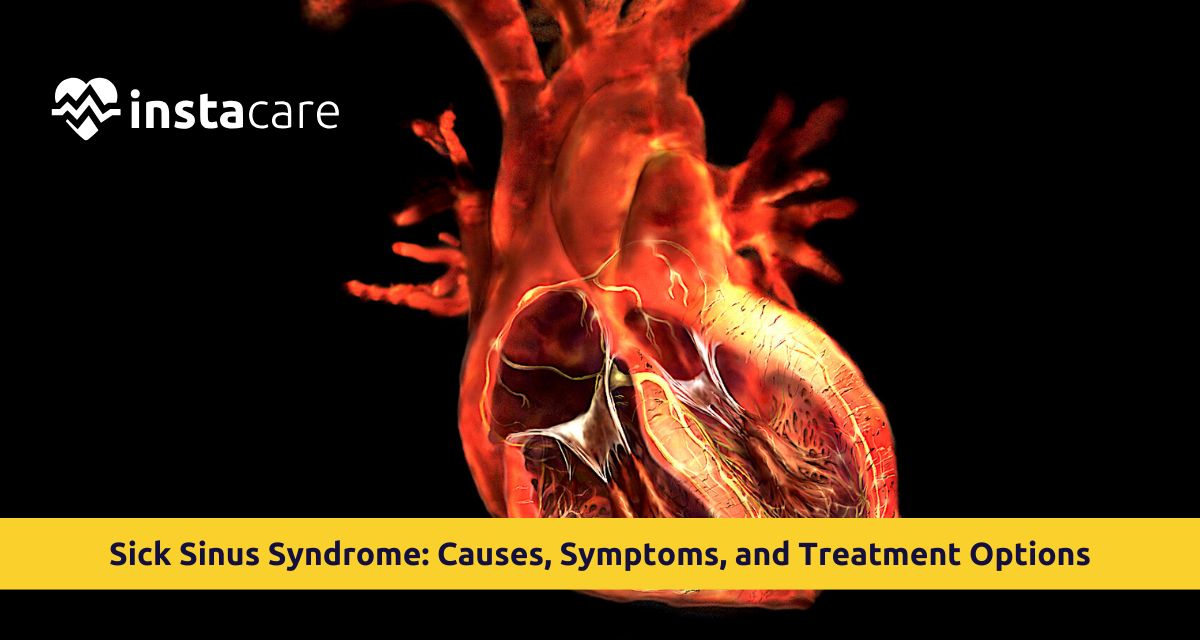Sick sinus syndrome (SSS) or sinus node dysfunction is a collection of cardiac rhythm disturbances of the heart's pacemaker, the sinoatrial (SA) node. SSS leads to inappropriate bradycardia, tachycardia, or irregular heart beat that disrupts normal electrical regulation of heart beat. Sick sinus syndrome is characteristically found in patients of advanced age and, if not treated, is potentially lethal. It is of greatest importance to recognize sick sinus syndrome so that it might be detected early and best treated as the early therapy with methods like pacemakers could enhance overall quality of life in an overwhelming majority of patients.
What is Sick Sinus Syndrome?
Sick sinus syndrome is a buildup of abnormal heart rhythms resulting from sinoatrial node dysfunction, a tiny cluster of specialized cells within the right atrium responsible for sending the electrical impulses that govern heartbeat. Normally, the SA node beats 60-100 times per minute to govern the pumping action of the heart.
Sick sinus syndrome pathophysiology involves degenerative changes in the SA node and supportive tissue. The node may beat too slowly (bradycardia) to supply inadequate blood to required organs or abnormally slow and fast irregularly alternating heart rates (bradycardia-tachycardia syndrome). The illness develops step by step, and the majority of the patients remain asymptomatic during an initial phase. Symptoms get worse and even reach a fatal stage when the SA node, however, continues to deteriorate.
Understanding Sick Sinus Syndrome
Sick sinus syndrome vs sinus bradycardia is an important distinction. Sinus bradycardia is essentially a state in which the heart is beating slowly but in a normal, sequential manner, usually in athletes or in sleep, and downright can be normal. Sick sinus syndrome involves the irregular, erratic beat of the heart in which the SA node is unable to have normal control.
Sick sinus syndrome in elderly population is most common because degenerative changes in cardiac tissue with age are the only solitary single most significant etiology. Approximately 1 of every 600 persons above age 65 develops the syndrome, and the frequency increases exponentially after the 70th year of age.
Sick sinus syndrome and atrial fibrillation frequently occur together. Alternating atrial fibrillation and bradycardia occur in most patients with SSS, also known as bradycardia-tachycardia syndrome. It is challenging to manage since medications that suppress reentrant rhythms also worsen the bradycardia.
Causes and Risk Factors
Sick sinus syndrome causes are multifactorial but the most frequent cause is age-related degeneration. In older individuals, cells in the SA node are replaced by fat and fibrosis tissues that inhibit the generation of electrical impulses.
Intrinsic SA nodal disease as a result of scarring or senility is most common. Other cardiac and coronary disease interferes with SA nodal blood supply. Before cardiac surgery, particularly surgery to the atria, injures covering tissue or SA node.
Certain drugs employed in sick sinus syndrome medications are toxic—beta-blockers, calcium channel blockers, digoxin, and antiarrhythmics inhibit SA node activity.
Hypothyroidism reduces metabolism like heart rate. Obstructive sleep apnea triggers frequent oxygen level drops that overload the cardiac electrical system. Cardiomyopathy, infiltrative disease like amyloidosis or sarcoidosis, and previous chest irradiation also make SSS dangerous.
Symptoms of Sick Sinus Syndrome
Sick sinus syndrome symptoms presentations range from none to horrific and sometimes life-threatening. The patient has some symptoms that at some time become apparent, thus making the diagnosis complicated.
- It begins with weakness and fatigue as presenting features, which are a consequence of the inability of low heart rates to pump enough blood to nourish the body. The dizziness and lightheadedness later follow as a consequence of impaired brain perfusion as a consequence of compromised blood supply. Fainting (syncope) is an even more sinister symptom, indicating greatly compromised brain perfusion.
- Shortness of breath and impaired exercise tolerance subsequently ensue because the heart cannot appropriately elevate its rate during effort. Palpitations or angina can accompany it, particularly with episodes of tachycardia.
- Confusion, memory loss, and mental deterioration may result from chronic decreased cerebral perfusion, particularly in the geriatric patient. Some patients will exhibit evidence of heart failure in the form of edema of the legs or dyspnea with supine posture.
- Sick sinus syndrome complications include stroke—irregular heart rhythms put the patient at risk of blood clotting. Disease over a long duration, if left untreated, results in heart failure. Unexpected death of the heart, although rare, is the most fatal complication.
How Sick Sinus Syndrome Is Diagnosed?
Sick sinus syndrome diagnosis is conducted by evaluation with appropriate assessment including history, physical examination, and special tests.
- Electrocardiogram (ECG) is the initial investigation. Sick sinus syndrome ECG findings may show sinus bradycardia (heart rate <60 bpm), sinus pauses (occasionally widened interval between beats >3 seconds), or changing bradycardia and tachycardia. However, a normal ECG may be found on one test in the absence of arrhythmias during the test.
- Holter monitoring monitors rhythm 24-48 hours a day and night continuously and detects periodic arrhythmias that routine ECG cannot detect. Event monitor patient wears for weeks or months and enables the patient to capture symptoms when occurring.
- Electrophysiologic testing involves catheterization via the vascular system to the heart and direct measurement of the SA node function. Exercise stress testing provokes to determine if heart rate increases normally with exercise—chronotropic incompetence is a hallmark of SSS.
Read More: Computer Vision Syndrome
Treatment Options for Sick Sinus Syndrome
Sick sinus syndrome treatment varies with the severity of symptoms, etiologies, and overall health.
- Treatment of sick sinus syndrome begins with treating reversible causes. Modification or withdrawal of medication that depresses SA node activity can increase symptoms. Treatment of related disease, for instance, sleep apnea or hypothyroidism, can normalize heart rate.
- Sick sinus syndrome pacemaker placement continues to be the only absolute treatment for symptomatic individuals with sick sinus syndrome. The tiny pacemaker inserted under the skin in the neckline area sends out electrical impulses to cause the heart to beat quickly enough. More recent pacemakers adjust heart rate with activity level, dramatically improving quality of life.
- Anticoagulants like warfarin or newer medication prevents stroke in atrial fibrillation patients. Rate-controlling medicines can be used to treat tachycardia attack attacks, but cautiously if bradycardia is made worse—typically after pacemaker implantation is the time to do so.
Living with Sick Sinus Syndrome
Sick sinus syndrome prognosis is normally excellent if properly treated. Pacemaker therapy optimizes survival and quality of life, and most return to normal activity.
Regular follow-up visits monitor pacemaker function, in addition to cardiac function. Exercise up to tolerance maintains cardiovascular muscle strength extremely high. Adequate weight, nutritious food intake, moderation with alcohol, and avoidance of smoking all contribute towards optimum result.
Sick sinus syndrome management includes:
- The patients must wear medical alert identification that states pacemaker presence and alert all staff
- Effective understanding of warning symptoms requiring immediate treatment recurrent dizziness, syncope, or chest pain—encourages patients for early treatment
Conclusion
Sick sinus syndrome is an intricate cardiac illness affecting the body's own inherent pacemaker of the heart, most often in aged people by virtue of age deterioration. Though the presentation ranges from mild fatigue to potentially life-threatening syncope attacks, with advancements in present-day diagnostic methods like ECG monitoring and electrophysiological testing proper diagnosis can be accomplished.
Pacemaker therapy provides highly effective management with satisfactory symptomatic patient outcome and quality of life. The majority of patients with sick sinus syndrome lead normal active lives and good long-term prognosis when provided with proper treatment and follow-up with a clinician.
Please book an appointment with the
Best Cardiologist in Lahore, Karachi, Islamabad, and all major cities of Pakistan through
InstaCare, or call our helpline at 03171777509 to find the verified doctor for your disease.

